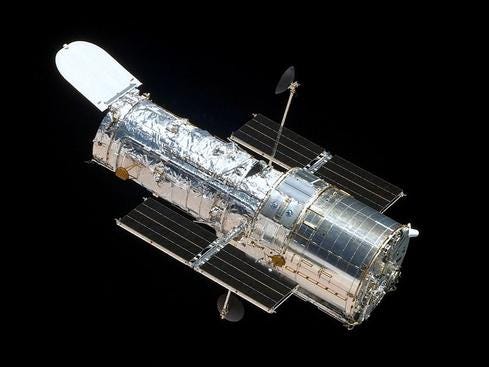The business model is changing when it comes to commercial space research.


Hubble Telescope: 25 Years Of Stunning Images
Hubble Telescope: 25 Years Of Stunning Images (Click image for larger view and slideshow.)
The business case for doing research in space is changing, even for commercial companies without huge research budgets. I know, just a few Geekends ago, I wrote an article criticizing the cost of space flight and big-ticket space research projects like the Webb Space Telescope.
Still, not all research in space is the same. The International Space Station (ISS) and the Center for the Advancement of Science in Space (CASIS) are making a case for the idea that every company might need to start thinking about a space research strategy.
CASIS is a non-profit set up by Congress designed to help run the US National Laboratory on the ISS. Its goal is to "commercialize" space by using a combination of seed money and outreach to draw companies and universities to experimenting on the ISS. The center has been quite successful in drawing both Fortune 100 companies and startups. And it's drawing from a wide range of types of companies, too.
Not surprisingly, CASIS has drawn pharmaceutical companies like Merck, but it has also engaged with well-known commercial brands, as well as technology companies working on the next generation of IT. We can't list them here at the moment, but trust me when I say some of the names would surprise you.
Cynthia Bouthot, director of business development at CASIS, explained in an interview the type of experiments and companies they are looking for.
"The real neat stuff is happening in commercial areas," Bouthot said, "If you think about pharma, things like protein crystallization or disease modelling to improve drug research. We're also working with engine companies on cheaper, lighter materials that don't crack. We're doing quite a bit with consumer product companies [we can't name yet], like experimenting with extending shelf life, figuring out the least amount of an ingredient you can put into something and still have it do what it is supposed to do."
Bouthot explains that CASIS is even working on things you'd never think about as experiments for space. "Like how do you get the oil to not sit on top of the peanut butter. The coolest part of this process is working with non-traditional players and having them really understand the potential," she said.
Here's a video of the latest projects to go up to the space station showing why the companies were interested.
Sure, microgravity is a real advantage, but isn't this all still really expensive?
[Want to see what big time space experiments look like? Read NASA MESSENGER Prepares for Impact on Mercury.]
Well, not as much as you'd think, because CASIS has an agreement with NASA for up-and-down mass. That's a fancy way of saying the CASIS equipment can hitch a ride on the ISS re-supply missions. One of the biggest costs of space research can be the sheer cost of putting the experiment in space, often as much $10,000 to $20,000 per pound. CASIS estimates that it can provide $7.5 million in value toward the cost of an experiment because of its agreements.
But take pharmaceuticals, for example. The average cost of developing a drug is now over $2.5 billion. Research in space can considerably quicken the time to market for drug research and can save money.
For example, osteoporosis drugs can be better researched in space. Humans lose bone density in space because of microgravity. The same is true of mice, which lose it even faster because of their shorter lifespan. It is an ideal place to test drugs to combat the issue.
CASIS works with companies to streamline and automate their experiments as much as possible so that they can be easily transported and operated in space.
In an interview with InformationWeek, Dr. Michael Roberts, senior research scientist at CASIS, explained why the ISS was so important: "Part of the unique advantage of the ISS is the microgravity. In absence of gravity researchers can get a better understanding of what is happening on the molecular level. It isn't about a better way to manufacture in space, but a better way to see what it is happening so you can better manufacture on earth."
"Right now, we are still at an age of fundamental understanding," added Roberts. In other words, we're still learning how molecules behave. Doing all of this in space allows us to learn without gravity acting on the molecules. It reduces variables and it keeps molecules from "settling" the way they might on Earth.
When asked whether companies had already turned space research into products, Roberts was quick to point out CASIS is only four-years-old. He pointed to success during the shuttle years, and then said, "We're on the cusp of having several investigations published that will have very profound impacts on biochemical research."
With pharma, consumer goods, aerospace, and semiconductor companies (among others) on board, soon you're going to need to get in line for space research. "We now have more customers and repeat customers coming than we can accommodate," said Roberts, "We are utilizing the full bandwidth."
"There was an education process to convince companies to move into these nontraditional areas," added Bouthot. "There has been a ramp up. And I'd say now it is a hockey stick. The growth is exponential."
In other words, the time to have a real space strategy is now. If you have an R&D budget, you need a space strategy. It is surprisingly cheap, and the number of products we're about to see developed in space are showing there is a clear ROI if you go there with a good plan.
[Did you miss any of the InformationWeek Conference in Las Vegas last month? Don't worry: We have you covered. Check out what our speakers had to say and see tweets from the show. Let's keep the conversation going.]
About the Author(s)
You May Also Like







